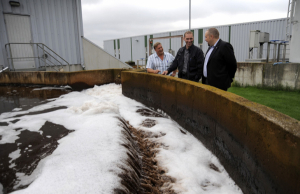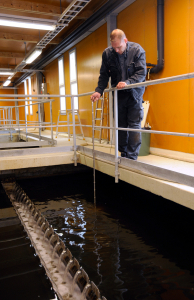Automation System Renews Wastewater Treatment Plant in Finland
We tend to think about it only when disturbances occur, but wastewater treatment is a basic public service that affects all of us:
it is vital to keep our living environment hygienic and healthy and our watercourses clean. Behind the scene, the wastewater treatment process combines microbiology and chemistry with mechanical engineering, instrumentation, and automation techniques that offer high performance in a progressive way.
Industrial wastewater treatment
The central wastewater treatment plant of a Finnish company receives household and industrial wastewater from different communities and utilities. "Around 60 percent of the water treated here is industrial wastewater," said the plant’s operating chief. Treatment of sewage including animal waste is especially laborious. "Compared to industrial sewage, we consider household wastewater to be clean enough to be used as a drink," he jokes. The automation of the whole system has to be considered with care.
Part of the company’s work involves maintaining central wastewater treatment plant in a nearby city. This is where the automation system had to be renewed.
An accurately controlled process
The process starts with the primary treatment, where the influent sewage water is strained to remove all large objects and the oxygen level of the water is increased to facilitate microbe activities (microbes clean the water by feeding on its impurities). During this biological treatment phase, the microbes in the wastewater are given suitable growing conditions in terms of temperature, oxygen level, and nutrition.
The next phase includes chemical secondary sedimentation, where aluminum-based chemicals are added to the water from the biological treatment to prompt flocculation of slowly-degrading organic and other materials. In the last phase, the remaining sludge is treated by removing water from it. The water separated from the sludge is taken back to the beginning of the treatment process, and the solid sludge is taken to the biogas plant.
High-tech automation system
The central wastewater treatment plant is fully automated. The automation system from 1992 reached the end of the road. Requirements for the technology selected to renew the wastewater treatment plant were:
- Ease of installation and maintenance
- Flexibility to adapt to fast-changing regulation
- Improvement of the overall solution
- Compliance with existing applications and methodologies
The whole system was renewed in 2008 in collaboration with Schneider Electric®. “The old automation system had served its time. We have been using it every day for the past 16 years," the operating chief explained. The original automation system involved six controllers from the TSX7 series, with Monitor 77/2 software environment, and used MAPWAY communication protocol. In the new solution, six Modicon® Premium™ controllers are implemented with Monitor Pro v7.6 and are using Modbus® TCP/IP over wireless, using nine of ProSoft Technology's industrial radios. About 2000 process variables are transiting over the wireless network, which is also used for programming and maintenance purposes.
Why wireless?
A total of seven locations had to be integrated into one single tight network. The 6 Modicon Premium controllers are located in different buildings at the wastewater treatment plant, and the plant has two control rooms. "We put the second computer here in this higher building so that our feet never get wet," the operating chief said. The plant is situated in an area prone to flooding. Of course, the plant can continue to operate even if the computers are down.
From the user point of view, the first advantage of the wireless networking option was the cost and time savings for the installation: no need to dig tranches, and no need to clean up existing cable paths.
From the integrator’s point of view, the wireless network was "the easiest part of the implementation. We didn't have any problems. These radios are very easy to configure, and mounting recommendations given by ProSoft Technology were very clear. Schneider Electric made some tests in their office and then explained to us how to implement the wireless network on the field."
From Schneider Electric’s point of view, the engineering of the network was reduced to a minimum. "When we started the project, we did not locally have any specific RF expertise," explains the then-Application Sales and Key Account Manager, Wood and BioEnergy, at Schneider Electric Finland. "We talked to ProSoft Technology Technical Support Engineers and provided them with the basic engineering and layout of the network. They made some calculations that where necessary for this type of application and they provided us with the recommended lists of accessories for each radio location: cables, antenna, lightning protector, etc. They also provided all the necessary recommendations for mounting and implementation in the field. The wireless network implementation was an easy job for us and our integrator.”
Long term investments
"The controls have been defined largely in the same way as in the old system," the plant’s operating chief explained. "Some of the old controls have remained the same, some have been added, and we have changed the commands a little bit." Since 1992, the plant has acquired a new sludge drying centrifuge and the treatment process has been modified by a new chemical treatment with aluminum. The automation system had to evolve accordingly.
"No controller can remain the same forever. There are always some additions and changes along the way. In this industry in particular, the regulations change quite a lot over the years as well," said the Schneider Electric sales manager, who took part in the plant’s original automation project in 1992.
The new setup is working well.
"We have not had any problems with the implementation of the new automation system. The graphics of the user interface have remained practically the same so we are familiar with the screens and don't need additional training," the plant’s operating chief said.
The reporting program in use is separate from the SCADA, but it reads data directly from the Modicon Premium controllers as well, via the same network.
In the future, the controllers can be easily modified or complemented when necessary with additional input or output modules. On the network side, the wireless option provides an additional degree of flexibility.
Learn more about ProSoft Technology’s Industrial Wireless Solutions here.




